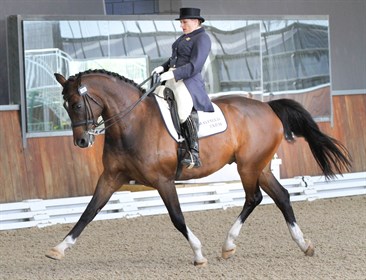|
This article has appeared previously with Equestrian Life. To see what is in our latest issue, please click here.

Kerry Mack and Mayfield Miracle.
© Michelle Terlato
By Kerry Mack
Leg aids are very important when riding, so let's get back to basics!
Legs connect anatomically to the pelvis. Your seat bones (part of the pelvis) rest either side of the horses back and stay still in relation to his back. You balance on your seat bones. Your legs hang down from the pelvis.
I am a great believer in 'heels down". Heels down stabilises your leg, which is especially important if you are jumping, doing games or anything else really active. When you jump your legs must work like the stable point that you can move around. You must press a little into the stirrup. For dressage heels down is not as important and a more neutral ankle is ok. Kyra Kyrkland for instance does not want to see heels down for dressage. However it is important how you get your heels down. Richard Weiss taught me to stretch the front of the thighs and stretch the back of the calves to make your leg long and the heel down. If you do this you will find that your knee remains bent, your heels remain underneath your hip and your seat does not get pushed up away from the saddle, all of which will happen if you put your heels down by straightening the knee. So push your knee forward and down stretching the front of the thigh. Keep you knee bent and stretch the back of your calves to send your heel down.
Of course if you are jumping your stirrups will be shorter, making it easier to keep bent hips, knee and ankles. If you are riding on the flat don't make the common mistake of having your stirrups too long. You shouldn't have to reach down for the stirrup.?Stretch up from the waist up, and down from the waist down, stretching the front of your thigh and the back of your calves. Repeat this wisdom of Richard Weiss's like a mantra. Remember that muscles work best when stretched, so stretch (you will hear more about this when we talk about training).
Legs must hang down in a relaxed way. It is your calf that gives the aids, not the heel, generally. When you use your leg don't clamp it on. Your legs aids should be like breathing. On and off, timed in relation to the phase of the stride. The timing isn't hard if you are balanced sitting on him and not gripping on to him. The timing then will just happen naturally. At canter your leg will wrap around him in the down beat, when the inside hind leg pushes off the ground.
When you use your leg use it quickly on, like breathing, and then off. It is removing pressure that trains (more about this later too). Legs must not nag the horse or he will learn to ignore the leg. A quick impulse, if he ignores it a stronger impulse or a good kick follows and if he still ignores it reinforce the aid with a tap from the whip. The whip reinforces the leg aid. The whip is not punishment. He learns to respond to a light aid when he knows that ignoring it results in the discomfort of stronger pressure, eg a kick or a tap with the whip.
Both legs together means go forward. One leg alone means yield sideways away, which use of the reins will determine if he leg yields, bends, shoulder in etc. One leg on the girth and one behind the girth, along with bend to the inside means transition to canter. In the collected work it is often the inside leg that controls the impulsion, for instance in a canter pirouette the inside leg can make the canter steps have more energy, more jump within the pirouette while the outside leg controls the hind quarter. But always leg on, leg off, breathing legs not squeezing legs. Never clamped on, gripping legs. Never continuously nagging legs, that only teaches the horse to ignore you, and desensitises him.
Have fun,
Kerry Mack
|

